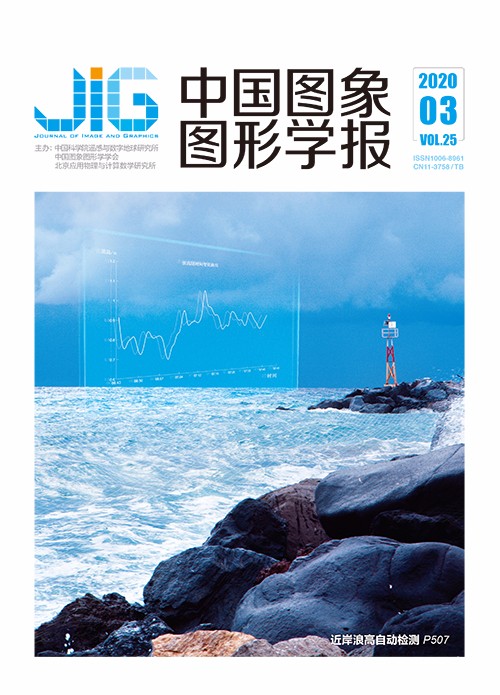
多标签高光谱图像地物分类
摘 要
目的 在高光谱地物分类中,混合像元在两个方面给单标签分类带来了负面影响:单类地物在混入异类地物后,其光谱特征会发生改变,失去独特性,使类内差异变大;多类地物在混合比例加深的情况下,光谱曲线会互相趋近,使类间差异变小。为了解决这一问题,本文将多标签技术运用在高光谱分类中。方法 基于高光谱特性,本文将欧氏距离与光谱角有机结合运用到基于类属属性的多标签学习LIFT(multi-label learning with label specific features)算法的类属属性构建中,形成了适合高光谱多标签的方法。基于标签地位的不相等,本文为多标签数据标注丰度最大标签,并在K最近邻KNN(k-nearest neighbor)算法中为丰度最大的标签设置比其余标签更大的权重,完成对最大丰度标签的分类。结果 在多标签分类与单标签分类的比较中,多标签表现更优,且多标签在precision指标上表现良好,高于单标签0.5% 1.5%。在与其余4种多标签方法的比较中,本文多标签方法在2个数据集上表现最优,在剩余1个数据集上表现次优。在最大丰度标签的分类上,本文方法表现优于单标签分类,在数据集Jasper Ridge上的总体分类精度提高0.2%,混合像元分类精度提高0.5%。结论 多标签分类技术应用在高光谱地物分类上是可行的,可以提升分类效果。本文方法根据高光谱数据的特性对LIFT方法进行了改造,在高光谱多标签分类上表现优异。高光谱地物的多标签分类中,每个像元多个标签的地位不同,在分类中可以通过设置不同权重体现该性质,提升分类精度。
关键词
Multi-label hyperspectral image classification
Zhang Jing, Wang Yibin, Fang Shuai(School of Computer Science and Information Engineering, Hefei University of Technology, Hefei 230601, China) Abstract
Objective A mixed pixel represents a number of ground features.The spectral curve of the mixed pixel is affected by a combination of these features, and nature corresponds to multiple categories of labels. The label information of a mixed pixel is represented by a single label in the single-label classification, which causes loss of information.In the classification of hyperspectral features, mixed pixels have negative effects on single-label classification in two aspects. When a single type of ground feature is mixed with a different type of ground feature, its spectral characteristics change,and it loses its uniqueness and causes a larger difference within the class.When the mixing ratio of multiple ground features increases, the spectral curves tend to be closer to each other so that the difference between classes becomes smaller.To resolve the conflict between single label frame and mixed pixel,we apply the technique of multilabel classification to the classification of hyperspectral features.Applying the technique of multi-label classification to hyperspectral feature classification, we assign a corresponding label to a pure pixel, and a mixed pixel is assigned a corresponding set of labels. The application of multi-label technology distinguishes between pure and mixed pixels so that the spectral curves of pure pixels of different features do not have large intraclass differences and can maintain their uniqueness. Pixels with a deeper mixing ratio can have multiple labels in a multi-label framework without being forced to retain only one label.Under the labeling of multiple labels, mixed pixels can retain most of the label information and can also avoid the precision degradation caused by single label classification. Method In the multi-label classification of hyperspectral features, the characteristics of hyperspectral data and unequal status of mixed pixel labels should be considered. Label-specific features in hyperspectral multi-label classification are observed, where a band feature combination with strong discrimination ability for a certain label exist. The similarity between hyperspectral curves can be measured by Euclidean distance and spectral angle. Based on hyperspectral characteristics, this paper organically combines Euclidean distance and spectral angle to build label-specific features of multi-label learning with label specific features LIFT algorithm.Thus, a new LIFT method suitable for hyperspectral multi-labels was born.Based on the inequality of label status, this study marks the label with the maximum abundance for the multi-label model, and sets a greater weight for the label with the maximum abundance than other labels in the KNN method to form the prediction of the maximum abundance label. Result The following results are obtained by comparing multi-label classification with single-label classification. On the Samson and Jasper Ridge datasets, multi-label classification performs better in all indicators than single-label classification. On the Urban dataset, multi-label classification performs better than single-label classification in indicator precision and indicator Fβ,and is not as good as single-label classification in indicator accuracy and indicator recall. Multi-label classification has achieved good classification results on hyperspectral images and performs well on precision indicators.In the comparison between the multi-label algorithm in this study and the other four multilabel algorithms, the algorithm in this paper has the best performance in two datasets and the second performance in the remaining one. The overall performance of the ML-KNN (multi-label k-nearest neighbor)and BR(binary relevance) algorithms is poor. In predicting the maximum abundance label, the method used in this study is superior to the single label prediction on the three data sets. Conclusion The application of multi-label classification techniques in the classification of hyperspectral features is feasible and can improve the classification effect. Different from the traditional multi-label classification, the characteristics of hyperspectral images are curves formed by reflectivity of hundreds of continuous narrow bands. The multiple labels of hyperspectral mixed pixels represent the ground feature information belonging to the pixel. Given the different abundance of ground features, these labels of ground features have different status. Therefore, in the multi-label classification of hyperspectral images, the sample characteristics and inequality on the labels should be considered. The multi-label method used in this study considers the label-specific features of hyperspectral multi-labels and applies the similarity measurement of hyperspectral curves to the construction of label-specific features, thereby successfully improving the classification effect on the basis of the hyperspectral data characteristics. In this paper, the method of maximum label abundance prediction is based on the consideration of label inequality, and the prediction result is better than that of single-label classification. The proposed methods based on the two special properties of hyperspectral multi-labels improve the classification effect. However, the improvement based on the two properties is split, and the two aspects can be combined in the future. Studying the multi-label classification of hyperspectral in the future requires an analysis of the spectral curves of pixels in different aspects and the information contained in them to design an algorithm suitable for the attributes of hyperspectral multilabel classification.
Keywords
remote sensing hyperspectral classification multi-label classification multi-label learning with label specific features(LIFT) label-specific feature spectral similarity
|



 中国图象图形学报 │ 京ICP备05080539号-4 │ 本系统由
中国图象图形学报 │ 京ICP备05080539号-4 │ 本系统由